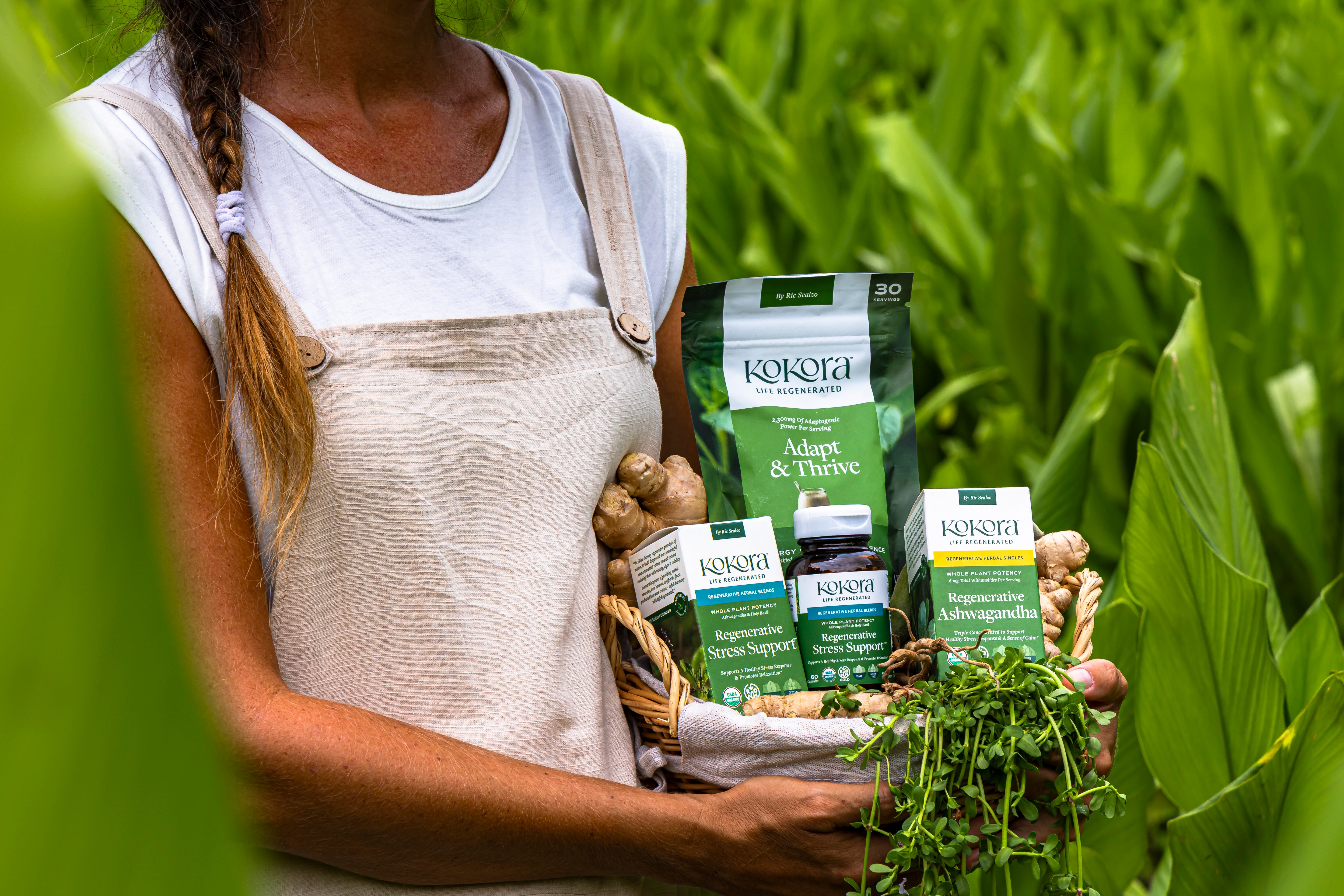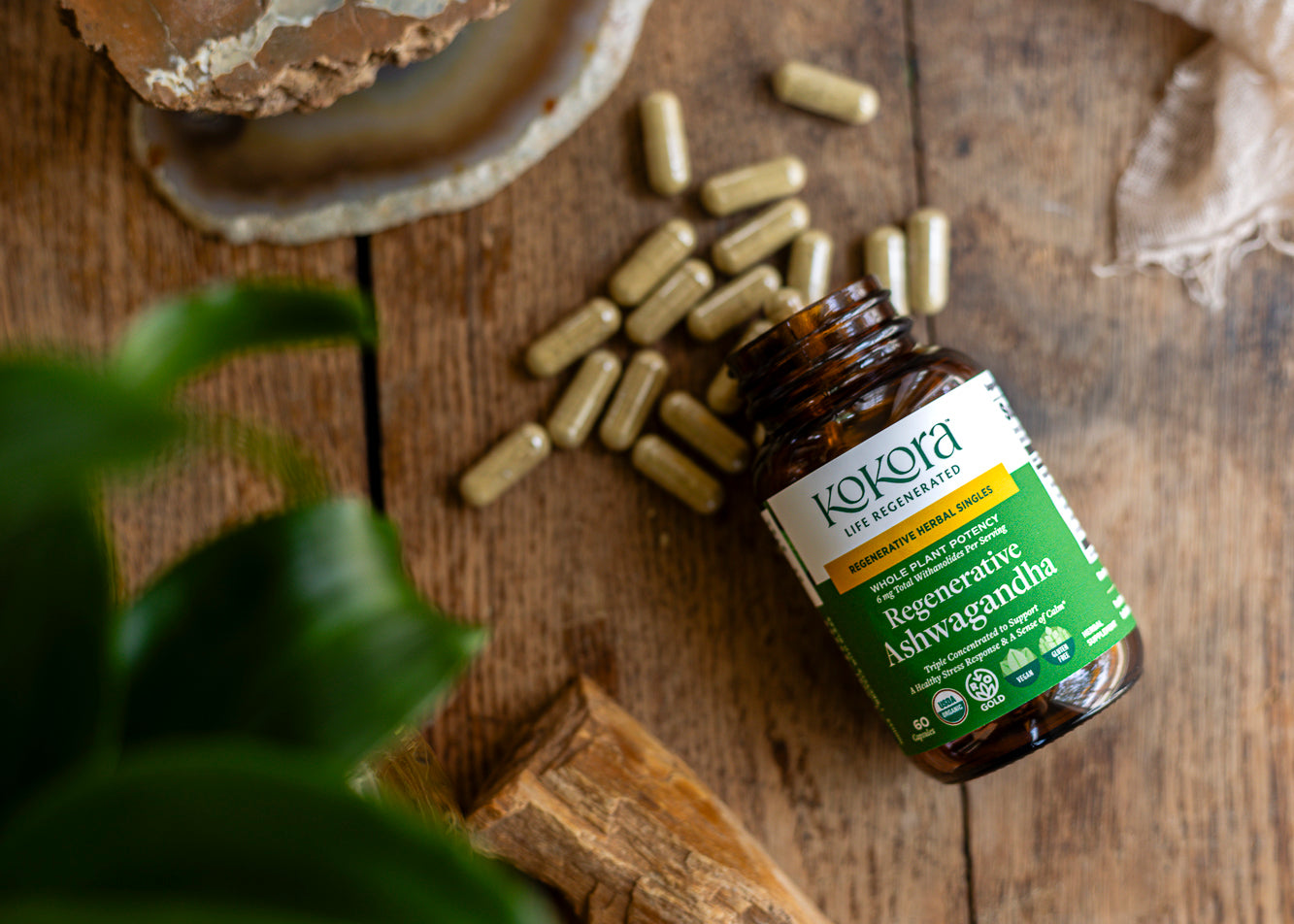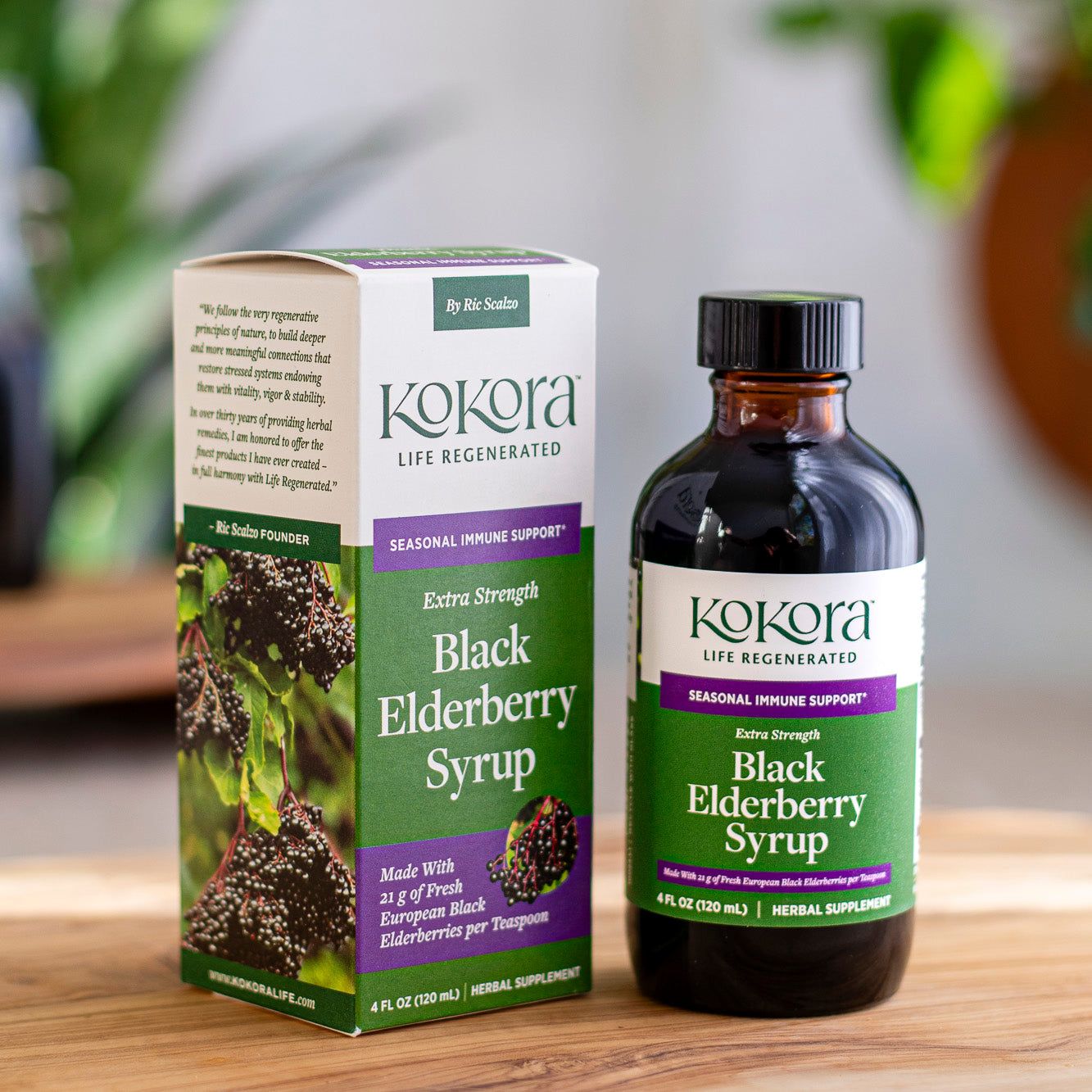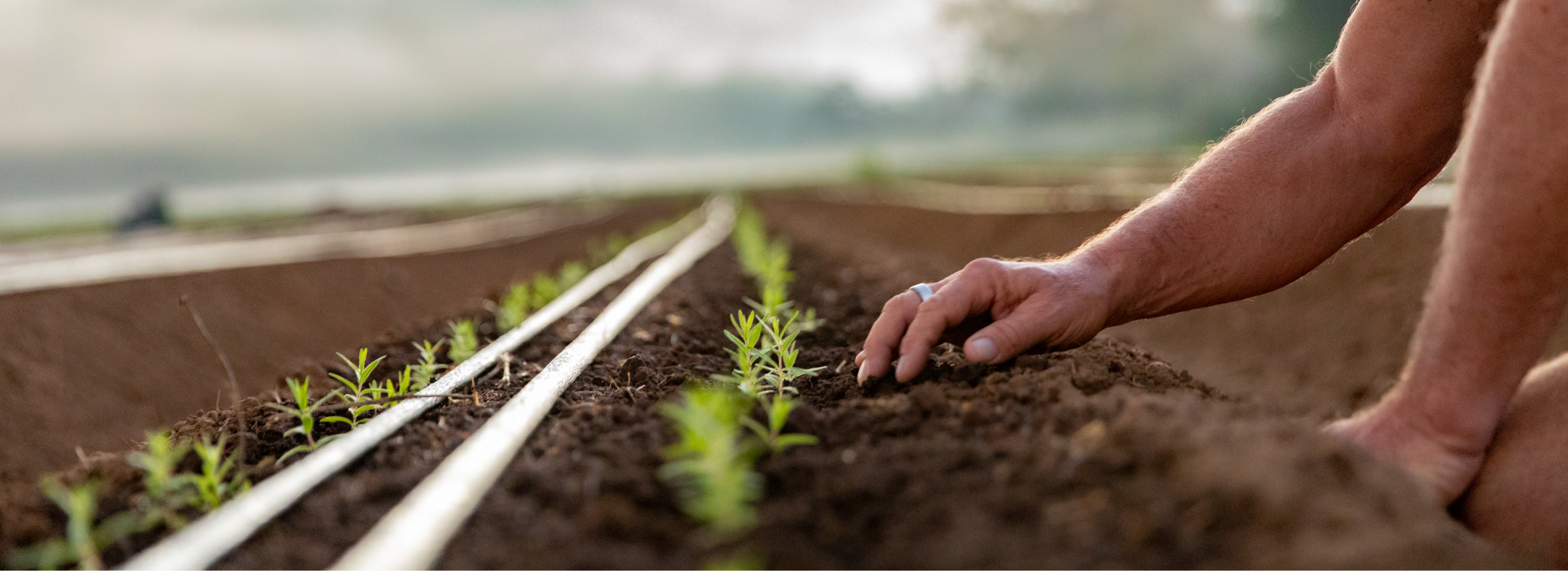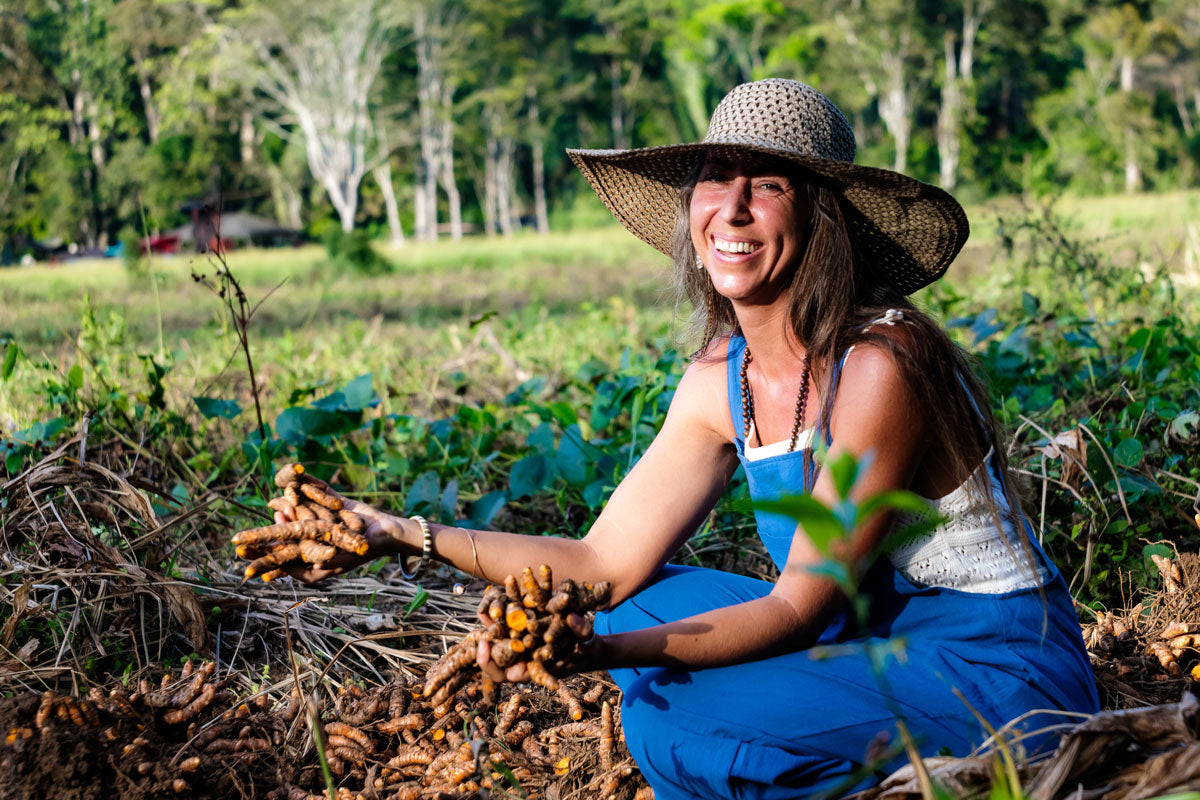Life begins in the soil
Many people think of soil as dirt. A simple combination of clay, sand, and silt. Devoid of nutrients. Lifeless.
But if you look at soil under the magic of a microscope, you’ll see that it’s incredibly, dynamically alive. Healthy, fertile soil is rich in organic matter, nutrients, water, and air, and it’s teeming with insects, worms, bacteria, fungi, nematodes, protozoa, and arthropods. A whole orchestra of life unseen.
Soil is life, because it is where the terrestrial food chain begins. Healthy soil grows strong, nutrient-rich plants. Herbivores feed on the plants, carnivores prey on the herbivores, and decomposers break down dead plants and animals, returning nutrients back to the soil. This interactive, dynamic cycle is what we call the soil-food web. It is Nature’s intelligence in action.
What is regenerative agriculture?
Regenerative agriculture is a farming practice that tends to the soil-food web. It recognizes a fundamental truth: that the health of the entire terrestrial food chain is dependent on healthy soil. That’s why the main goal of regenerative farming is to reenergize, revitalize, and regenerate the soil. To give more to the soil than we take away. Regenerative farms, like the farm Kokora operates in Costa Rica, are focused on building up the top four to six inches of soil, leaving it richer in nutrients and more varied in lifeforms than it started with.
This is a profound departure from the agricultural practices of the past 70 years. The main goal of conventional agriculture is to maximize yield, whatever the cost. And the costs have been great. With its destructive practices, conventional agriculture has depleted and eroded the soil, polluted the environment, harmed wildlife, destroyed habitats, depleted the water, hastened climate change, and sickened humans.
We are at a crisis point. The planet is close to exceeding a critical temperature threshold beyond which there is no return. And yet, we at Kokora remain hopeful! We are energized by the knowledge that regenerative farming can positively influence the well-being of everything and everyone — plants, people, and planet.
Principles of regeneration
Every living thing, from the smallest cell to the largest ecosystem, is capable of regeneration. Of renewing that which has been depleted or degraded. Of becoming whole again. But there is a specific sequence that must be followed.
Centuries ago, a branch of natural medicine known as physiomedicalism identified three steps necessary for healing the human body: rest, restore, and revitalize. As a practicing herbalist, Kokora founder Ric Scalzo discovered first-hand how important following this sequence was.
He observed that alternative medicine practitioners would often jump straight to prescribing their patients herbs for their specific health complaint. But inevitably, the herbs wouldn’t work. Ric understood that this was not because they were the wrong herbs. They were the right herbs, prescribed at the wrong time.
He recognized that an ill body is a body with a stressed physiology. And a stressed physiology, a physiology that is stuck in “fight or flight” mode, cannot heal. It first has to be brought to a state of rest. It must move from the vigilant mode of the sympathetic nervous system to the restful mode of the parasympathetic system. Only then can healing and recovery happen.
Ric realized that his first job as a healer was to take a step back and help his patients return to a state of physiological rest. This crucial step allowed their bodies to relax enough to receive the healing properties of the herbs. And invariably, when these patients took the same herbs that had once been ineffective, they suddenly started working.
As the founder and formulator of Gaia Herbs, Ric applied these principles to every formula he developed for 34 years. It was only recently, when he turned his sights toward a new venture of creating an herbal product line made exclusively with regeneratively grown botanicals, that Ric had an “aha moment.” He realized the very same principles of “rest, restore, revitalize” also apply to farming regeneratively.
Principle 1: First, rest.
To bring human physiology to a state of rest, you must remove what is known in homeopathy as “obstacles to cure.” Because if you don’t eliminate the stressors that are pushing the body out of homeostasis — in other words, if you don’t address the root cause of illness — you cannot achieve healing. It’s like trying to fill a bucket with a hole in it without patching the hole.
The first step to recovery, then, is to eliminate toxins from the body and stop destructive patterns, such as eating poorly, being sedentary, and not getting adequate sleep.
As it is with the human body, so it is with the soil. Regenerative agriculture recognizes that the first step to improving soil health is to remove the things that are harming it. That means eliminating toxic synthetic inputs and reducing destructive farming practices.
Eliminating synthetic inputs
It’s widely known that synthetic inputs — like chemical fertilizers, pesticides, and herbicides — harm animals, people, and planet. But they’re also devastating to the life unseen in the soil.
The sole purpose of these industrial chemicals is to kill life. Much like antibiotics, they are indiscriminate in their destruction. They kill not only unwanted bacteria, viruses, fungi, and insects, but also the beneficial microbes and bugs that make soil healthy.
In addition to being poisonous, these chemicals speed up climate change at every stage of their production, transport, use, and disposal.
Sadly, relying on pesticides creates a vicious cycle. They release greenhouse gases into the atmosphere, warming the planet. Warmer climates lead to more pests, which then require more pesticides.
Thus, we come to the great irony of relying on synthetic inputs to maximize profit. While it may temporarily increase yields and save money, in the long run it makes the land less productive and more costly to manage.
It may be surprising to discover that regenerative farming, which eliminates synthetic inputs completely, actually increases yields compared to conventional chemical-heavy agriculture. Farming studies show this to be true for almost all food crops, including common ones like corn, wheat, rice, soybean, and sunflowers.
Stopping over-farming
The farmers of old knew something that modern, industrialized agriculture has forgotten: planting the same crop in the same soil year after year is not a good farming practice.
It’s not hard to understand why. Different plants have different nutritional requirements. For example, tomato plants need calcium to prevent blossom end rot, a common disease that makes the fruit susceptible to decay. Calcium isn’t much of a concern for corn, but magnesium is. When corn lacks sufficient magnesium, chlorophyll production and photosynthesis are both impaired, resulting in stunted growth and reduced yield.
Continuously planting the same crop in the same field exhausts the soil of specific nutrients. Over time, this leads to nutrient depletion, greatly reducing soil fertility and requiring the use of synthetic fertilizers to compensate.
Similarly, different plants are vulnerable to different pests. Monocropping, or planting only one type of crop, is an excellent way to entice pests and diseases to make a permanent home in a farmer’s field. Why would they leave when they have a guaranteed supply of their favorite food?
The primary goal of regenerative farming is to enrich the soil, not deplete it. For this reason, regenerative agriculture not only grows a diverse range of crops but rotates which crops grow where. These practices help keep the soil healthy and the pests at bay.
At the Kokora Farm, we use both crop diversification and crop rotation. Currently, we cultivate 10 herbs: ashwagandha, turmeric, ginger, andrographis, Chinese skullcap, passionflower, bacopa, Mucuna, melissa (lemon balm) and tulsi (holy basil), with plans to expand over time. Each herb is grown in a different field each season, ensuring that our fertile, volcanic soil remains rich in nutrients.
Reducing tilling
Soil has a natural structure, consisting of particles organized into clumps of various shapes and sizes known as aggregates. Think of it as a jar full of different-sized marbles, with plenty of air pockets between them. This soil structure enables water to enter and drain, oxygen-rich air to circulate, nutrients to nourish the root zone, and microbes to do their important work.
Tilling disturbs soil structure. It breaks up soil aggregates into smaller, uniformly sized particles. Instead of marbles, picture now the jar full of sand. Since these smaller particles nest closer together, there is less space for air and water movement, root growth, and microbial activity. This phenomenon is called soil compaction, and it creates a cascade of issues for the soil-food web:
- Soil compaction makes it harder for plants to take root and grow because they can’t get the essential elements they need to thrive.
- Soil that is extremely compacted cannot manage water. Since there is nowhere for the water to drain, the soil becomes stagnant, and disease sets in.
- Soil compaction also increases erosion, as the smaller soil particles are more easily carried away by wind and water.
- Finally, compacted soil harms entire ecosystems, because sediment from soil erosion clogs waterways, increases flooding and landslides, and contributes to loss of habitat and biodiversity.
Stopping or minimizing tilling preserves healthy soil structure and prevents soil compaction. It is one of the most important things we do at the Kokora Farm.
Principle 2: Next, restore.
In the physiomedical model, once a patient has achieved a state of physiological rest, it’s time to progress to the next step: restoring optimal functioning of the body.
Humans suffer from many health issues, but most stem from just a few underlying causes. These include systemic inflammation, which can damage healthy cells, tissues, and organs; dysfunction of the vagus nerve, which reduces the ability to handle stress; altered cellular metabolism, which disrupts energy production, cell growth, and homeostasis; and a disrupted gut microbiome, which can lead digestive problems, mood disorders, and increased susceptibility to infection.
The second step in healing the body, then, is to restore whatever is out of balance, whether that be inflammation, vagal response, cellular metabolism, or gut microflora. It is the same with soil. The second step in improving soil health is to restore microbe populations, mycelia networks, soil structure, and carbon stores.
Restoring microbe populations
Soil harbors a vast community of microorganisms, including bacteria, fungi, and protozoa. Remarkably, just one teaspoon of healthy soil holds billions of these tiny creatures!
Soil microbes play many important roles in supporting plant, human, and planetary wellness.
- They create healthy soil structure by binding soil particles together to create aggregates.
- They release nutrients trapped in organic matter, which plants and other soil organisms can use.
- They prevent plant diseases by keeping soil-borne pathogens and pests in check.
- They form symbiotic relationships with plants, aiding plant growth, health, and resilience.
- They detoxify contaminants in the soil, such as pesticides, heavy metals, petroleum hydrocarbons, and organic pollutants.
- They take the carbon that plants absorb from the atmosphere and bond it to minerals. This creates a stable form of carbon that can stay locked away in the soil for thousands of years.
Conventional farming methods reduce both the abundance and diversity of soil microbes, with disastrous effects. In contrast, regenerative agriculture creates conditions for microbes to thrive.
Regenerative farms like Kokora promote microbial health by adding organic matter, such as compost and worm castings, to the soil. We never leave soil barren, even for a week, or else microbes die off. Instead, we plant cover crops when fields are not in use to keep the microbes happy. We rotate crops to ensure biodiversity above and below the ground. And we do not use chemical fertilizers, pesticides, or herbicides, which can be toxic to microorganisms.
Restoring mycelia networks
Looking at a cluster of mushrooms from above ground, it’s natural to assume they are separate, individual fungi. But just like cherries on a tree are all fruiting from the same organism, mushrooms in a cluster are all fruiting from the same fungus. Only in their case, the “mother organism” lives beneath the soil.
The below-ground portion of fungi is known as mycelia, which are much like the roots of a tree. These mycelia form intricate networks, linking individual plants together in what is cleverly termed “the woodwide web.”
Through mycelia networks, plants such as trees can exchange water and nutrients. For example, saplings in densely shaded forests often lack sufficient sunlight for photosynthesis. In response, taller, more established trees share nutrients and sugar with the saplings through the mycelia network, enabling their survival.
Mycelia networks are incredibly fragile. The filaments of mycelia, called hyphae, typically measure a mere 4-6 microns in diameter — or 4 to 6 thousandths of a millimeter. Intensive soil tilling breaks apart mycelia networks. This explains why conventional farms have much fewer soil fungi than no-till systems like regenerative agriculture.
Restoring soil structure
Healthy soil structure, where soil particles form aggregates, brings many benefits:
- It makes it easier for water and air to move through the soil, reducing water runoff, soil erosion, and soil compaction.
- Surprisingly, it also helps soil retain water better. Organic farming methods have been shown to double yields during drought years compared to conventional methods.
- Stable soil aggregates are less likely to be washed or blown away, minimizing soil erosion. This is crucial because the Earth loses an estimated 36 billion tons of topsoil every year.
- Good soil structure encourages plant roots to grow deeper, allowing them to access water and nutrients more efficiently. This leads to stronger, more resilient plants.
- Soil aggregates help build up organic matter, which helps draw down carbon dioxide from the environment and lock it away in the soil.
Regenerative farms like Kokora improve soil structure through practices such as rotating crops; planting cover crops; adding organic matter through composting, mulching, and incorporating crop residues; and fostering microbial diversity.
Restoring soil carbon
Conventional agriculture is a significant contributor to climate change, making up about 10 percent of U.S. greenhouse gas emissions. Agricultural machinery burns fossil fuels, synthetic fertilizers release greenhouse gases from the soil, and practices like tilling, monoculture cropping, and agrochemical use all let stored carbon escape.
To stop the Earth from getting any hotter, we must draw down carbon from the atmosphere. It’s no longer enough to be carbon neutral. We can’t be satisfied with not adding any new carbon to the air. We have to remove the carbon that’s already there.
This is where regenerative agriculture gets really exciting. Because this method of farming is extremely effective at pulling carbon out of the atmosphere and storing it in the soil.
According to Rodale Institute, if we switched all farming around the world from conventional to regenerative systems, we could draw down more carbon dioxide than we emit annually. With this one act, we could go beyond simply becoming carbon neutral — we could actually remove some of the “legacy” carbon that’s already in our environment.
Imagine that! Even if we kept burning the same amount of fossil fuels as we do now, we could still reverse our carbon footprint just by changing the way we farm. Of course, if we also cut our carbon emissions, switching to regenerative agriculture globally would make even more of a difference. But the impact that farming regeneratively could make on its own is truly astonishing.
Principle 3: Finally, revitalize.
Returning to our physiomedical model, the third principle of regeneration is revitalization. This last step is when we experience true healing.
It’s tempting to jump straight to the revitalization stage when we’re ill. But revitalization is not possible until the body has returned to a state of physiological rest and optimal functioning has been restored. Only then can the vital force flow into the tissues unobstructed.
With the vital force flowing freely, the body now has a heightened state of adaptation. In other words, it has a greater capacity to manage stress.
This ability to adapt has a profound effect on both our physical and emotional state. Because the truth is, there is no stress in life. There are only stressful responses. Events themselves aren’t inherently stressful; it’s how we respond to events that determines their effect on us. Having a greater stress tolerance allows us to move through the inevitable challenges of life with greater ease and less dis-ease.
This wisdom applies to agriculture as well. The soil-food web can only experience revitalization once the soil has been allowed to rest and its health restored.
Regenerating the soil revitalizes the entire ecosystem. All the beneficial organisms within it now have a greater capacity to handle stress. Thus, they experience increased vigor, greater resilience to environmental hardships, and improved resistance to disease.
Allowing plants to reach their full potential
Plants are only as healthy as the soil they are grown in. On the most basic level, soil serves as the primary source of water and essential nutrients necessary for photosynthesis and plant growth. But as we’ve already established, the health of soil is determined by so much more than its moisture and nutrient content.
Healthy soil is alive. It harbors a diverse community of beneficial microorganisms that aid in cycling nutrients, suppressing disease, and improving soil structure. It’s interlaced with mycelia networks that enhance plants’ ability to absorb water and essential nutrients. And it’s home to pest-controlling nematodes and soil-aerating earthworms.
Healthy soil is structured. It’s arranged into aggregates that allow for water and air to circulate and plant roots to penetrate, creating the optimal conditions for plant growth.
Healthy soil is fertile. It’s rich in organic matter, such as compost and mulch, which enhances nutrient availability and promotes phytochemical production.
With its focus on soil health, regenerative agriculture allows plants to reach their full potential — strong and resilient, with sturdy root structures and abundant growth, rich in beneficial phytochemicals and potent in healing power.
Positively influencing human physiology
Regenerative farming benefits humans too, beyond saving the planet we inhabit. It directly impacts our physiology.
Regenerative farming vastly increases the number, variety, and activity of microorganisms in the soil. When plants interact with the soil, the soil microbes colonize the plants’ roots and other tissues. They essentially become part of the plant. This means that when humans eat plants, we eat their microbes as well.
In a surprising development, scientific investigation has found that it’s not always the phytochemicals in medicinal herbs that are responsible for their beneficial effects. Sometimes, it’s actually the microorganisms in the herb that are doing the work.
The authors of a 2023 review article appearing in the Journal of Functional Foods speak to this phenomenon.
“Humans have been consuming medicinal plants (as herbs/spices) to combat illness for centuries while ascribing beneficial effects predominantly to the plant/phytochemical constituents, without recognizing the power of obligatory resident microorganism’ communities (MOCs) (live/dead bacteria, fungus, yeast, molds etc.) which remain after industrial microbial reduction methods.”
They go on to write that only a few research groups have been able to remove the microorganisms from the herbs they study, and that their work suggests that “immune activation may not be from the plant but rather its microbial biomass; a hypothesis we corroborate.”
The Kokora Difference
Kokora is transforming the way herbal medicines are made, from soil to cells.
We grow and harvest our herbs with reverence for nature, using regenerative farming practices. We extract and concentrate our herbs with reverence for plants, using techniques that preserve their phytochemical density. And we test the activity of our herbs with reverence for humans, using a range of scientific validation methods.
Regenerative Farming
An obvious benefit of regenerative agriculture is its environmental impact. This way of farming not only restores the soil but also draws down atmospheric carbon. In essence, it is working with nature instead of against it.
Less well-known is the fact that regenerative systems create more nutritious, health-giving plants with a full spectrum of beneficial nutrients and phytochemicals. A recent study of eight pairs of farms across the United States found that compared to conventional farming methods, regenerative practices yield crops with greater levels of vitamins, minerals, and phytochemicals.
These results mirror our own personal experience at the Kokora Farm. Years ago, when our founder Ric Scalzo was regularly purchasing turmeric from a supplier in Indonesia, analytical testing showed the material had about 2 percent naturally occurring curcumin. The turmeric we grow regeneratively on our farm in Costa Rica is now testing at up to 8 percent curcumin. That’s a four-fold difference. Talk about phytochemical density!
Full-Spectrum Potency™
Every medicinal herb is its own little miracle. It contains a full spectrum of phytochemicals, present in specific amounts and ratios, that together deliver a complete healing message to the body.
Each step of our process at Kokora — from growing and harvesting to extraction and concentration — is precisely calibrated to increase the phytochemical density of our herbs without upsetting the natural balance of constituents. The end result is an herbal product that is much more potent than the raw herb, yet still presents the wisdom of nature unchanged. We call this Full-Spectrum Potency™.
Full-Spectrum Growing
The primary reason the Kokora farm is achieving such high phytochemical density is that regeneratively farmed soil is exceptionally healthy, and healthier soil equals more nutritious plants. This link was confirmed in the Montgomery study mentioned above, which investigated soil health in addition to crop nutrient and phytochemical density. Not only did the regeneratively farmed soil have twice as much carbon as the conventional soil, but its soil health score was, on average, about three times as high.
Full-Spectrum Harvesting
Another reason for our extraordinary phytochemical density is Kokora’s precise timing of harvests to coincide with our plants peak phytochemical levels. For annual herbs, this peak usually happens during or just before the flowering stage. Perennial herbs, on the other hand, typically reach their highest phytochemical levels during the period of vigorous growth in spring or early summer. However, every herb has its own rhythm, and we harvest each one according to its own unique timetable.
Full-Spectrum Extraction
Many players in the herbal products industry adopt a reductionist approach to herbal medicine. They aim to pinpoint an herb’s “active constituent,” and then selectively extract the herb to artificially increase levels of that specific phytochemical. Yet attributing an herb’s action solely to one constituent is misguided. Eliminate some of the phytochemicals and you change the plant’s healing message.
This is not to say that selectively extracted herbs are ineffective, because many scientific trials have shown otherwise. But when you take a complex herb and distill it down to one main constituent, you essentially create a drug. This approach not only loses the synergy of multiple compounds working together to produce therapeutic effects but can also lead to safety issues that weren’t present with the whole herb. The more herbal products resemble drugs, the more targeted their action, and the more likely they are to have side effects.
At Kokora, we have tremendous respect for nature’s intelligence. We believe that every phytochemical in a medicinal herb has a role to play. That’s why we use extraction techniques that retain the full spectrum of phytochemicals found in the whole herb, leaving only the inactive cellulose behind. Additionally, we use only pure organic grain alcohol and water to extract, never harsh industrial solvents like hexane or acetone. Because toxins have no place in your herbal products.
Full-Spectrum Concentration
Just as important as how Kokora extracts our herbs is how we concentrate them. Many people don’t know that virtually all powdered herbal extracts on the market today are spray-dried at extremely high heat onto highly processed carriers such as maltodextrin.
This concentration method presents two issues. First, excessive heat can destroy delicate herbal constituents, reducing the effectiveness of the extract. Secondly, the food additive maltodextrin has adverse effects on the human microbiome. It decreases beneficial bacteria while promoting harmful bacteria. It’s worth nothing that carriers like maltodextrin are not present in insignificant amounts in herbal extracts. They can make up 30-50 percent of the final product.
Kokora is at the forefront of herbal concentration technology. Our herbs are concentrated using a freeze-dried process that preserves all of the phytochemicals in their natural ratios and eliminates the need for carriers, binders, and fillers. They are pure herbal extracts and nothing else. A direct communication from nature to your cells.
Scientific Validation
Without scientific validation, the principle that regeneratively grown herbs are better for you is just an idea. The only way to know for certain that our herbs have elevated phytochemical density and vibrant cellular activity is to subject them to rigorous testing.
Phytochemical Density Validation
Nature is not predictable. Even with the most careful farming methods, herbs differ in their phytochemical makeup from one harvest to the next. However, as a consumer, you want each bottle of product you buy to have the same phytochemical profile and density. Otherwise, one bottle might be effective while another might not. That’s why it’s crucial for herbal manufacturers to ensure that their starting materials have consistent levels of phytochemicals.
Before any herb makes it into Kokora products, we analyze it for phytochemical density through high-performance liquid chromatography (HPLC), gas chromatography-mass spectrometry (GC-MS), or thin-layer chromatography (TLC). Only those herbs that match the phytochemical benchmarks we have established can proceed to the next step of active cellular assurance.
Active Cellular Assurance
Once we have validated the phytochemical density of our herbs, it’s time to investigate how they interact with human cells. This is where Kokora is truly breaking new ground. Every Kokora herb is subjected to comprehensive bioassay testing at the Ric Scalzo Institute of Botanical Research at Sonoran University of Health Sciences in Tempe, Arizona.
A bioassay is an analytical technique used to investigate the specific effects of a substance on different cells within the body. Kokora uses bioassays to answer three basic questions:
- Is it safe? The first bioassay measures various cellular endpoints to determine if the herb has any cell toxicity.
- Is it stable? The second bioassay mimics the gastric environment to see if the herb survives stomach acid unharmed.
- Is it effective? Finally, a series of bioassays, custom-tailored to each herb, ascertain whether it has beneficial physiological impacts on human cells. For example, an energy herb may be evaluated to see how it affects ATP production and mitochondrial function.
To be perfectly transparent, these bioassays are in vitro, meaning they are conducted on human cells that are cultured in a laboratory setting. They do not carry the weight of well-controlled human clinical trials. However, they do signal how the herb is likely to behave inside living humans, which informs how we formulate.
Active Cellular Formulation
Active cellular assurance provides evidence that our herbs are safe, stable, and effective on their own. But medicinal herbs are most powerful when they are artfully combined into formulas that have a strength beyond their individual ingredients.
It is this kind of synergy that Aristotle referred to 2,000 years ago when he wrote, “The totality is not, as it were, a mere heap, but the whole is something besides the parts.”
At Kokora, we thoughtfully formulate multi-herb products with phytochemical synergy in mind. We use the principles of several schools of traditional healing — including Ayurveda and Traditional Chinese Medicine from the East and eclectic medicine and physiomedicalism from the West — to develop our formulas, carefully considering how each herb will contribute to the total medicinal impact.
What is truly unique about our formulation strategy, though, is that it is guided in real time by bioassays conducted at Sonoran University of Health Sciences. These bioassays are able to precisely quantify the synergistic effect that occurs when multiple herbs interact with living human cells. With this knowledge, we learn how different combinations of herbs harmonize to address specific functional health benefits, such as energy production or immune function, enabling us to make the most effective herbal formulas possible.
A new path forward
The stakes for life on earth are dire. The planet heats up more with every passing year. Biodiversity is collapsing, with one million species at serious risk of extinction. Conventional farming practices and the misuse of arable land have now degraded 75% of the Earth’s land areas.
“As a global society, we continue to trade our soil and our future for short-term profits and status quo production models,” the Rodale Institute aptly observes.
But we don’t have to continue down this road. We can use the revolutionary power of regenerative agriculture to forge a new path. To rest, restore, and revitalize the soil and all of the living things that depend on it: the microbes, insects, plants, animals, humans, habitats, ecosystems, and planet. Join us.
References
https://rodaleinstitute.org/wp-content/uploads/Rodale-Soil-Carbon-White-Paper_v11-compressed.pdf
https://www.nationalforests.org/blog/underground-mycorrhizal-network
https://link.springer.com/chapter/10.1007/978-981-99-8220-2_12
https://rodaleinstitute.org/wp-content/uploads/Rodale-Soil-Carbon-White-Paper_v11-compressed.pdf
https://rodaleinstitute.org/wp-content/uploads/Rodale-Soil-Carbon-White-Paper_v11-compressed.pdf
https://www.ers.usda.gov/topics/natural-resources-environment/climate-change
https://www.frontiersin.org/articles/10.3389/fsufs.2021.699147/full
https://www.sciencedirect.com/science/article/pii/S1756464623002876
https://www.ncbi.nlm.nih.gov/pmc/articles/PMC8801175/
https://www.webmd.com/diet/what-is-maltodextrin
https://se-scholar.com/se-blog/2017/6/23/who-said-the-whole-is-greater-than-the-sum-of-the-parts
https://rodaleinstitute.org/wp-content/uploads/Rodale-Soil-Carbon-White-Paper_v11-compressed.pdf

